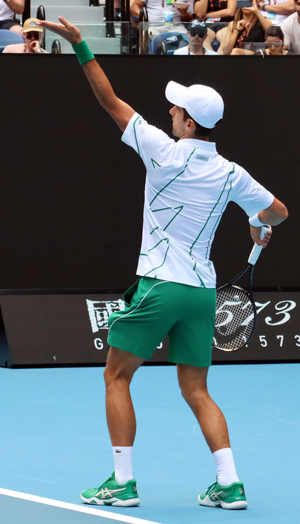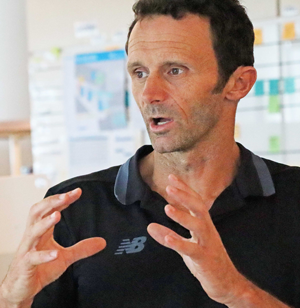VIEW AND DOWNLOAD WORLD TENNIS GAZETTE VOL. 12 NO. 9
By JOHN MARTIN

World Tennis Gazette/John Martin
MELBOURNE, Australia — As Jim Courier leaned forward, he tilted his microphone toward Novak Djokovic, who had just defeated Yoshihito Nishioka of Japan in the third round of the 2020 Australian Open. They stood on the Rod Laver Arena court.
“Novak,” Courier said, “your coaching team is said to be looking for ways to improve your serve. Tell me, how can you improve your serve?”
“Hit more aces?” Djokovic replied with a smile in his voice. The audience roared with laughter.
The Serb had just hit 17 aces and only two double faults over three sets, holding his serve 13 consecutive times.
Courier and Djokovic stood less than 100 yards from where a digital study of the serve had been underway for some time. Its goal: create a new way to evaluate and improve the serve. Something called Serve Value is the first digital step.
The leader of the study, Dr. Machar Reid, directs a team of scientists working in artificial intelligence for Tennis Australia. They form a team called Game Insight Group, or GIG.
Standing over his laptop on the seventh floor of the nearby Tennis Australia headquarters, Reid chatted with a young colleague as a photographer snapped shots of the maze of computers and desks.
Reid is an author and sports scientist deeply invested in both the theoretical and the practical.
“What Serve Value does is it combines the speed of someone’s serve, the placement of their serve, and the spin of their serve with a view to giving you one number on a scale of 0 to 100, where you’re able to rate the effectiveness of your serve, each and every serve that’s hit. So, it’s the likelihood of my serve winning the point.”
In 2015, Reid co-wrote Tennis Science: How Player and Racket Work Together, a look at many facets of the sport, including an effort to describe “the main technological developments and software programs that can be used to assist in performance and notational analysis in tennis.“

World Tennis Gazette/John Martin
At times, data science is thick with complex technical terms aimed at capturing insights. Reid simplified:
“You’re essentially looking at the relationship between ball speeds, spin and placement, and the point outcome,” Reid said. “So, did the combination of those factors allow any particular player to win the point?”
Reid said his team uses a database of Hawk-Eye video stretching back more than four years, a vast compendium of a hundred thousand or more first and second serves and the points they won or lost.
One striking discovery, he said, is that Djokovic, for example, ranks well below the top first servers, but records a remarkable high second serve rating.
“Novak wins approximately, 50, 55 percent of second server’s points,” Reid said. “That’s a combination of his serve directly winning those points, which happens quite a bit for Novak relative to a lot of other players, and then also his rally ability relative to a lot of other players.”
One result, Reid said, is “this gives you probably the sport’s first attempt at trying to put first serves and second serves, treat them the same way, consider them on the same scale, and say, okay, how effective is someone’s second serve, really?”
One question is whether a Serve Value rating is of more use to the server or the opponent.
“I think it’s far more actionable for the player, not so much the opponent,” Reid said. “So, a lot of stats in tennis focus on me preparing to meet a certain opponent. Here, this is about, as much as anything, monitoring my own improvement, my own serve performance over time. So, if my serve value drops from tournament to tournament or year to year, that’s something that I can control.”
A partner in the study, Victoria University Professor of Sports Analytics Sam Robertson was quoted by the Tennis Australia website:
“Using science to measure speed is easy, using science to measure the value of a shot not so much. Serve Value brings tennis in line with many other major sports who are developing new and informative ways to quantify the skill of its players.”

World Tennis Gazette/John Martin
For players (and magazine writers) unfamiliar with data science, the terrain can be especially daunting. Dr Reid’s online bio sketch lists some projects in the field of research. Three examples make the case that there is a bright but sometimes baffling future for data science in sport:
“A qualitative exploration of mentally tough behaviour in Australian football.”
“Chronic Adherence to a Ketogenic Diet Modifies Iron Metabolism in Elite Athlete(s).”
“Different visual stimuli affect muscle activation at the knee during sidestepping.”
Some equally sophisticated measures are in various stages of development elsewhere.
Cyclists, for example, can use a particularly rigorous scale called “Suffer Score.”
“Suffer Score is one index made up of a few combined data areas,” said Robert Kitchingman, an avid competitive cyclist (and friend of the writer) who lives in Melbourne. He listed heart rate and power output as measures.
“VO2 Max is another measure based on the body’s ability to produce oxygen,” he said.
After opening day of this year’s Australian Open, Dr. Reid said that among all competitors who were rated using Serve Value, the first serve of Sam Querry of the United States ranked highest at 96. At 87, Serena Williams’s first serve ranked highest among women.
By Friday of the first week of play, Querry had slipped to third and Williams had dropped off what Tennis Australia called the leaderboard (see chart).
Djokovic’s first serve was not among the top five men. His second serve was reported at 28.86.
Dr. Reid was asked what this meant.
What “28 indicates, in this context,” he said, “is 28 percent of Novak Djokovic’s second serves are likely to result in him directly winning the point, so forcing his opponent to make a mistake off the return or even potentially hitting a second serve ace.”
In the five-set final, Djokovic hit only 9 aces, but won 66 of 87 points (76%) on his first serve and 24 of 47 second serves (51%).(As Reid forecast.)
Final Score: Djokovic won 6-4, 4-6, 2-6, 6-3, 6-4
An ATP analyst observed “Djokovic won 24 of his 29 points at the net and hit 46 winners, including nine aces. Thiem won 29 of 134 points on return of serve and committed 57 unforced errors, the same number as Djokovic. Each player also hit five double faults.”
Was champion Djokovic aware of the Serve Value forecast that his second serve would be vital? WTG will get back to you on that.